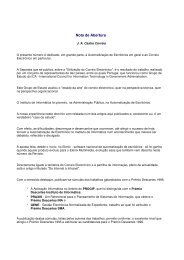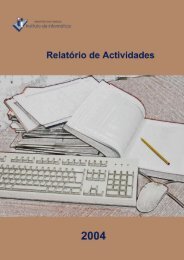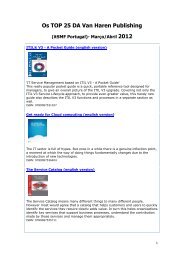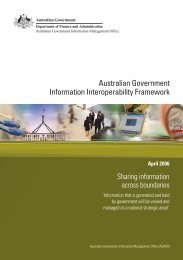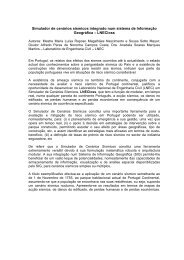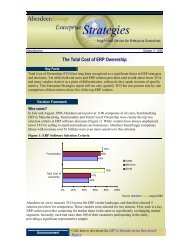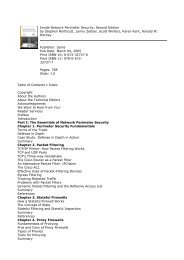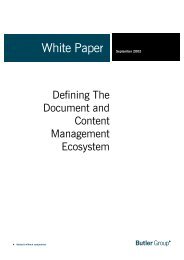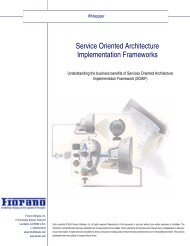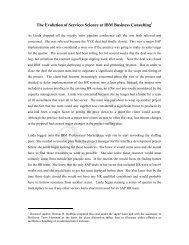OECD Peer Review of E-Government in Denmark - ePractice.eu
OECD Peer Review of E-Government in Denmark - ePractice.eu
OECD Peer Review of E-Government in Denmark - ePractice.eu
Create successful ePaper yourself
Turn your PDF publications into a flip-book with our unique Google optimized e-Paper software.
government as far as possible. Among the objectives for eDay 2 was an expectation <strong>of</strong> achiev<strong>in</strong>g a<br />
further 40% reduction <strong>in</strong> paper-based communications by November 2005.<br />
By 1 February 2005, nearly 92% <strong>of</strong> the 382 organisations subject to the requirements <strong>of</strong> eDay 2<br />
had met them. This required that they implement digital signatures and establish appropriate means for<br />
the receipt and management <strong>of</strong> secure digitally signed e-mail. The rema<strong>in</strong><strong>in</strong>g 8% <strong>of</strong> organisations<br />
(ma<strong>in</strong>ly small municipalities) were simply be<strong>in</strong>g slightly delayed due to m<strong>in</strong>or technical issues related<br />
to their implementation <strong>of</strong> digital signatures. Aside from a further round <strong>of</strong> cost sav<strong>in</strong>gs (which were<br />
expected to double with eDay 2) the <strong>in</strong>itiative was expected to deliver flow-on benefits <strong>in</strong> terms <strong>of</strong><br />
easier and more secure exchange <strong>of</strong> <strong>in</strong>formation, better quality services, and better responsiveness to<br />
citizens and bus<strong>in</strong>esses.<br />
A survey <strong>of</strong> the impact <strong>of</strong> eDay 2 conducted <strong>in</strong> April 2005 showed that 19% <strong>of</strong> organisations still<br />
sent and/or received a lot <strong>of</strong> paper-based communications, while a further 71% did so to a more<br />
limited extent. Even though it is not feasible that paper-based communication with and with<strong>in</strong><br />
government can be completely elim<strong>in</strong>ated <strong>in</strong> the foreseeable future, these figures <strong>in</strong>dicate that there are<br />
still opportunities for government to <strong>in</strong>crease the use <strong>of</strong> digital communication, and enhance the<br />
result<strong>in</strong>g performance benefits and cost sav<strong>in</strong>gs.<br />
Other conclusions drawn from the survey suggested that achiev<strong>in</strong>g a higher degree <strong>of</strong> electronic<br />
communication was conditional upon time and adjustment <strong>of</strong> the communications behaviour <strong>of</strong><br />
government organisations, citizens and bus<strong>in</strong>esses. Aga<strong>in</strong>, organisations considered eDay 2 to have<br />
been both an organisational and technological challenge, but with eDay 2 the organisational aspect<br />
was generally considered slightly more difficult than the technical one. Internal bus<strong>in</strong>ess processes<br />
changed as a result <strong>of</strong> eDay 2 for approximately 90% <strong>of</strong> organisations.<br />
Lessons from eDay implementation<br />
The importance <strong>of</strong> the eDay bus<strong>in</strong>ess case<br />
One <strong>of</strong> the biggest impacts <strong>of</strong> the eDay <strong>in</strong>itiative is that, once it is fully implemented, all Danish<br />
government organisations will have adopted the use <strong>of</strong> digital signatures and established means for<br />
exchang<strong>in</strong>g secure electronic communications via e-mail. This has created a level <strong>of</strong> e-government<br />
read<strong>in</strong>ess that, at least <strong>in</strong> the area <strong>of</strong> electronic communication, is yet to be achieved <strong>in</strong> many if not all<br />
other <strong>OECD</strong> countries. On its own, this would be an impressive achievement. It is made more so by<br />
the fact that, <strong>in</strong> the case <strong>of</strong> both eDays, adherence to the objectives was not made mandatory by the<br />
<strong>Government</strong>, but <strong>in</strong>stead left entirely voluntary.<br />
One <strong>of</strong> the keys to achiev<strong>in</strong>g this level <strong>of</strong> commitment has been the strong bus<strong>in</strong>ess case<br />
underp<strong>in</strong>n<strong>in</strong>g eDay implementation. For the first eDay there was an expectation that 75% <strong>of</strong> <strong>in</strong>ternal<br />
paper-based government correspondence would be able to be conducted electronically. Some <strong>of</strong> the<br />
direct benefits (i.e. exclud<strong>in</strong>g ga<strong>in</strong>s <strong>in</strong> organisational performance and the quality <strong>of</strong> public services)<br />
expected were:<br />
• Annual sav<strong>in</strong>gs <strong>of</strong> 300 tonnes <strong>of</strong> paper and EUR 25 million <strong>in</strong> postage costs, and undef<strong>in</strong>ed<br />
sav<strong>in</strong>gs from reduced costs <strong>of</strong> <strong>in</strong>ternal mail handl<strong>in</strong>g.<br />
• A doubl<strong>in</strong>g <strong>of</strong> uptake <strong>of</strong> digital signatures <strong>in</strong> the public sector.<br />
• Benefits related to wider use <strong>of</strong> electronic document management systems.<br />
157



